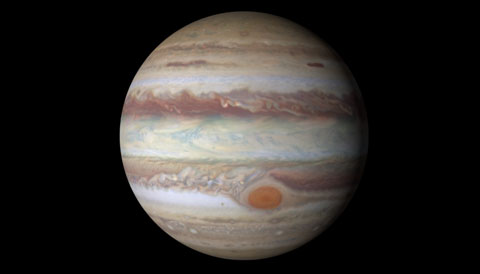A Hubble legacy program has returned high-res Jupiter images, revealing changes to the Great Red Spot and mysterious new wisps in the North Equatorial Belt.
Observe Jupiter through a telescope, and you’ll soon find it’s not immutable as the stars.

It’s a place where storms rage and winds reach speeds of more than 200 miles per hour. Even long-lived features such as the Great Red Spot, which has so far survived for hundreds of years, are in flux.
Recently, astronomers started a program to have the Hubble Space Telescope send home annual Jupiter images and the other outer planets, like a planetary yearbook. Dubbed the Outer Planet Atmospheres Legacy (OPAL) program, the annual imaging of Jupiter, Saturn, Uranus, and Neptune will continue as long as Hubble still flies. (For now, though, Cassini rather than Hubble will provide the pictures of Saturn. Hubble will take over whenever Cassini is decommissioned.)
Like any good photographer, OPAL will ensure that we don’t capture just a single view: each annual look will capture two full orbits so that investigators can study not just yearly changes but daily ones too.
Hubble observed its first planet in November 2014, sending back Jupiter images of mysterious bright spots in Uranus’s atmosphere. Then in January 2015, Hubble captured high-res shots of Jupiter. Watch this video to see the new view of Jupiter — it’s awesome in the most literal sense:
And these are far more than pretty pictures. The newest observations confirm that the Great Red (or should we call it orange?) Spot continues to shrink, losing girth to become more circular. Although its shrinkage had appeared to speed up in 2014, these newest observations show its back to the normal rate, decreasing in size by 0.19° of longitude (about 225 km) per year.
As it shrinks, the core of the Great Red Spot, once a distinct piece of this anticyclone and prominent at violet wavelengths, seems to have mostly disappeared. Swirling filaments have appeared in its place.

Hubble also captured a rare wave train just north of the planet’s equator in the North Equatorial Belt, a region dotted with cyclones. Such a feature hasn’t been seen in more than a decade of previous Hubble observations, spanning 1994 to 2014, nor was it seen by the Galileo or Cassini spacecraft. The only other spacecraft to spot the feature (barely) was Voyager 2 during its 1979 flyby.

The preliminary report on Hubble’s OPAL images, in a study led by Amy Simon (NASA Goddard), appears in October 7th's Astrophysical Journal, but there’s plenty of data here to keep Jupiterphiles busy until the next yearbook picture arrives.
 3
3









Comments
Gregory
October 16, 2015 at 4:15 pm
Wow. These pics are almost as good as Damian Peach's stuff! (scroll down to his movie here http://damianpeach.com/jup1415.htm )
You must be logged in to post a comment.
rick
October 16, 2015 at 8:02 pm
Oh no! Jupiter and the outer planets have caught global warming from Earth! Call Al Gore!
You must be logged in to post a comment.
doug-champion
October 16, 2015 at 8:32 pm
These photos truly are stunning. Thank you
You must be logged in to post a comment.
You must be logged in to post a comment.